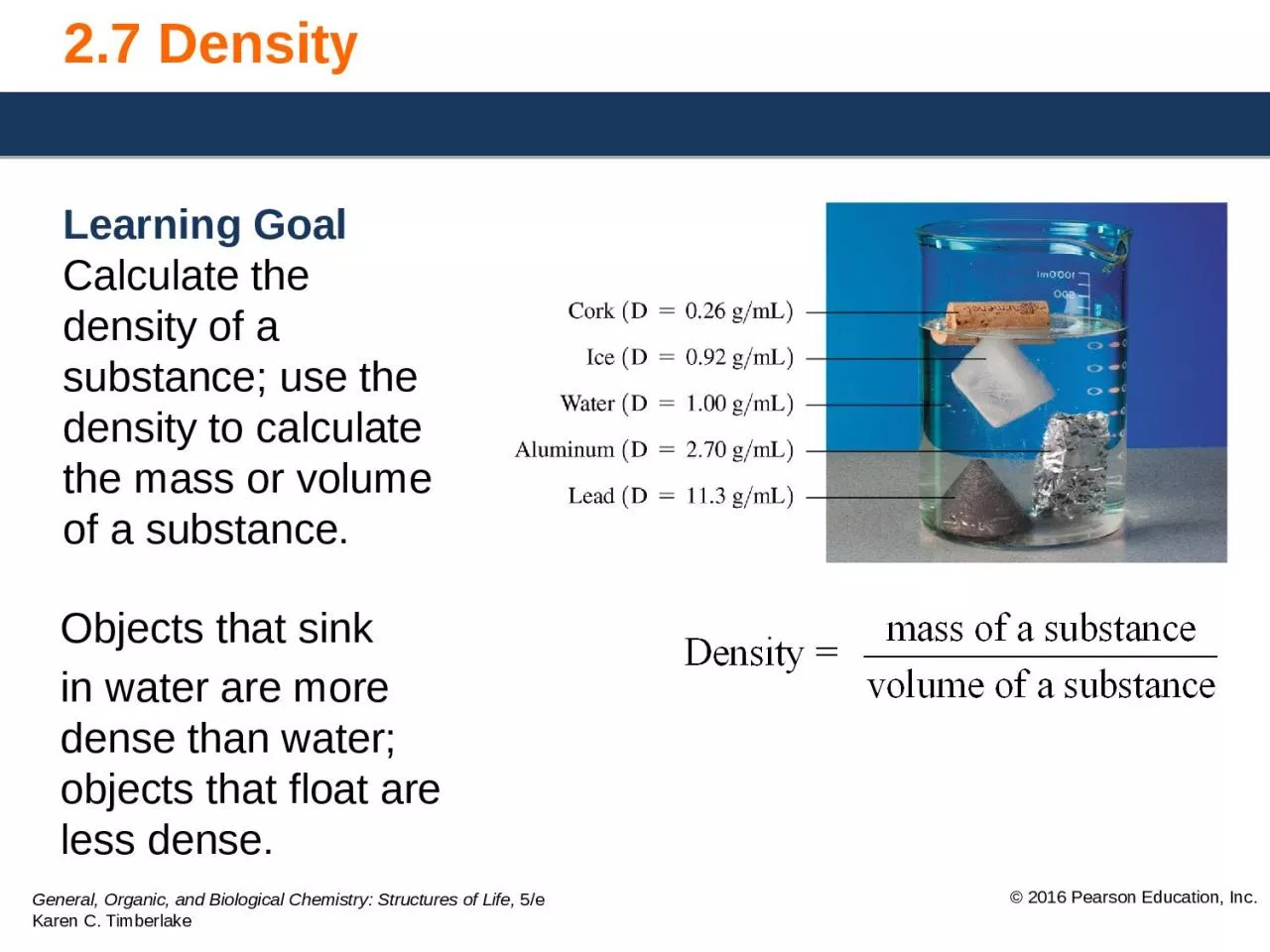

in water are more dense than water objects that float are less dense Learning Goal Calculate the density of a substance use the density to calculate the mass or volume of a substance Densities of Common Substances ID: 1026128
Download Presentation The PPT/PDF document "2.7 Density Objects that sink" is the property of its rightful owner. Permission is granted to download and print the materials on this web site for personal, non-commercial use only, and to display it on your personal computer provided you do not modify the materials and that you retain all copyright notices contained in the materials. By downloading content from our website, you accept the terms of this agreement.
1. 2.7 DensityObjects that sink in water are more dense than water; objects that float are less dense.Learning Goal Calculate the density of a substance; use the density to calculate the mass or volume of a substance.
2. Densities of Common Substances
3. Calculating DensityDensity compares the mass of an object to its volume.
4. Density of SolidsThe density of a solid can be determined by dividing the mass of an object by its volume.
5. Density Using Volume DisplacementThe density of the solid zinc object is calculated by dividing its mass by its displaced volume. To determine its displaced volume, submerge the solid in water so that it displaces water that is equal to its own volume. Density calculation:45.0 mL − 35.5 mL = 9.5 mL = 9.5 cm3
6. Study CheckWhat is the density (g/cm3) of a 48.0–g sample of a metal if the level of water in a graduated cylinder rises from 25.0 mL to 33.0 mL after the metal is added? object33.0 mL 25.0 mL
7. SolutionWhat is the density (g/cm3) of a 48.0–g sample of a metal if the level of water in a graduated cylinder rises from 25.0 mL to 33.0 mL after the metal is added?
8. Problem Solving Using DensityIf the volume and the density of a sample are known, the mass in grams of the sample can be calculated by using density as a conversion factor. Core Chemistry Skill Using Density as a Conversion Factor
9. Problem Solving Using Density Example: John took 2.0 teaspoons (tsp) of cough syrup. If the syrup had a density of 1.20 g/mL and there is 5.0 mL in 1 tsp, what was the mass, in grams, of the cough syrup? STEP 1 State the given and needed quantities. STEP 2 Write a plan to calculate the needed quantity. teaspoons milliliters gramsANALYZE GIVEN NEEDTHE PROBLEM 2.0 tsp syrup density of syrup (1.20 g/mL) grams of syrupU.S.−MetricFactor DensityFactor
10. John took 2.0 teaspoons (tsp) of cough syrup. If the syrup had a density of 1.20 g/mL and there is 5.0 mL in 1 tsp, what was the mass, in grams, of the cough syrup? STEP 3 Write the equalities and their conversion factors, including density.Problem Solving Using Density
11. Problem Solving Using Density John took 2.0 teaspoons (tsp) of cough syrup. If the syrup had a density of 1.20 g/mL and there is 5.0 mL in 1 tsp, what was the mass, in grams, of the cough syrup? STEP 4 Set up the problem to calculate the needed quantity.
12. Specific GravitySpecific gravity (sp gr) is a relationship between the density of a substance and the density of water.is calculated by dividing the density of a sample by the density of water, which is 1.00 g/mL at 4 °C.is a unitless quantity.A substance with a specific gravity of 1.00 has the same numerical value as the density of water (1.00 g/mL).
13. Study CheckAn unknown liquid has a density of 1.32 g/mL. What is the volume (mL) of a 14.7-g sample of the liquid?
14. Solution An unknown liquid has a density of 1.32 g/mL. What is the volume (mL) of a 14.7-g sample of the liquid? STEP 1 State the given and needed quantities. STEP 2 Write a plan to calculate the needed quantity. grams millilitersANALYZE GIVEN NEEDTHE PROBLEM 14.7 g liquid density of liquid (1.32 g/mL) volume of liquidDensityFactor
15. SolutionAn unknown liquid has a density of 1.32 g/mL. What is the volume (mL) of a 14.7-g sample of the liquid? STEP 3 Write the equalities and their conversion factors, including density.
16. SolutionAn unknown liquid has a density of 1.32 g/mL. What is the volume (mL) of a 14.7-g sample of the liquid? STEP 4 Set up the problem to calculate the needed quantity.
17. Concept Map